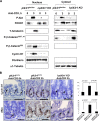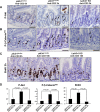Phosphoinositide 3-kinase signaling mediates beta-catenin activation in intestinal epithelial stem and progenitor cells in colitis
- PMID: 20580720
- PMCID: PMC2930080
- DOI: 10.1053/j.gastro.2010.05.037
Phosphoinositide 3-kinase signaling mediates beta-catenin activation in intestinal epithelial stem and progenitor cells in colitis
Abstract
Background & aims: Mechanisms responsible for crypt architectural distortion in chronic ulcerative colitis (CUC) are not well understood. Data indicate that serine/threonine protein kinase Akt (Akt) signaling cooperates with Wingless (Wnt) to activate beta-catenin in intestinal stem and progenitor cells through phosphorylation at Ser552 (P-beta-catenin(552)). We investigated whether phosphoinositide 3-kinase (PI3K) is required for Akt-mediated activation of beta-catenin during intestinal inflammation.
Methods: The class IA subunit of PI3K was conditionally deleted from intestinal epithelial cells in mice named I-pik3r1KO. Acute inflammation was induced in mice and intestines were analyzed by biochemical and histologic methods. The effects of chemically blocking PI3K in colitic interleukin-10(-/-) mice were examined. Biopsy samples from patients were examined.
Results: Compared with wild-type, I-pik3r1KO mice had reduced T-cell-mediated Akt and beta-catenin signaling in intestinal stem and progenitor cells and limited crypt epithelial proliferation. Biochemical analyses indicated that PI3K-Akt signaling increased nuclear total beta-catenin and P-beta-catenin(552) levels and reduced N-terminal beta-catenin phosphorylation, which is associated with degradation. PI3K inhibition in interleukin-10(-/-) mice impaired colitis-induced epithelial Akt and beta-catenin activation, reduced progenitor cell expansion, and prevented dysplasia. Human samples had increased numbers of progenitor cells with P-beta-catenin(552) throughout expanded crypts and increased messenger RNA expression of beta-catenin target genes in CUC, colitis-associated cancer, tubular adenomas, and sporadic colorectal cancer, compared with control samples.
Conclusions: PI3K-Akt signaling cooperates with Wnt to increase beta-catenin signaling during inflammation. PI3K-induced and Akt-mediated beta-catenin signaling are required for progenitor cell activation during the progression from CUC to CAC; these factors might be used as biomarkers of dysplastic transformation in the colon.
Copyright © 2010 AGA Institute. Published by Elsevier Inc. All rights reserved.
Figures







Comment in
-
Caught in the Akt: regulation of Wnt signaling in the intestine.Gastroenterology. 2010 Sep;139(3):718-22. doi: 10.1053/j.gastro.2010.07.012. Epub 2010 Jul 24. Gastroenterology. 2010. PMID: 20659460 Free PMC article. No abstract available.
References
-
- Franklin WA, McDonald GB, Stein HO, et al. Immunohistologic demonstration of abnormal colonic crypt cell kinetics in ulcerative colitis. Hum Pathol. 1985;16:1129–32. - PubMed
-
- Cheng H, Bjerknes M, Amar J, Gardiner G. Crypt production in normal and diseased human colonic epithelium. Anat Rec. 1986;216:44–8. - PubMed
-
- Bjerknes M, Cheng H. Gastrointestinal stem cells. II. Intestinal stem cells. Am J Physiol Gastrointest Liver Physiol. 2005;289:G381–7. - PubMed
-
- Gregorieff A, Pinto D, Begthel H, et al. Expression pattern of Wnt signaling components in the adult intestine. Gastroenterology. 2005;129:626–38. - PubMed
Publication types
MeSH terms
Substances
Grants and funding
LinkOut - more resources
Full Text Sources
Other Literature Sources
Medical
Molecular Biology Databases
Miscellaneous

